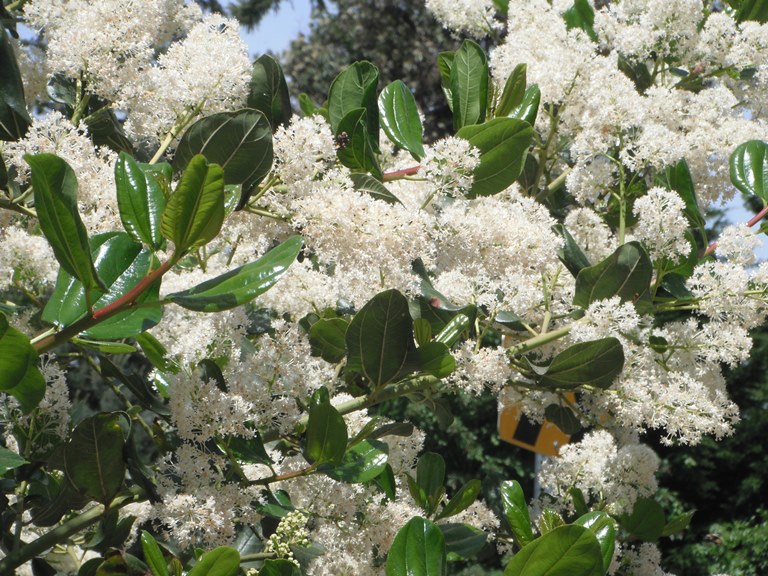

Na tive Plants Network, Propagation Protocol Database Although there is no evidence that seeds are disseminated by anything but gravity, the white, fleshy arils may entice ants to distribute the seeds.

Use by Wildlife: It is considered an important forage food for deer, elk and moose. Use by people: Oregon Boxwood is sometimes used as greenery in floral arrangements, but care should be taken not to decimate native populations when collecting. Seed propagation is difficult but success may be achieved with a cool stratification period for several months. Propagation: Oregon Boxwood is easily propagated by softwood cuttings or by layering. Phenology: Bloom Period: April-June Seed capsules ripen July-September.

It needs a well-drained soil it will not perform well with too much water. It can be used as a border or a low-growing hedge, or in a woodland garden or rock garden. In the Landscape: Oregon Boxwood can be used similarly as are the cultivated shrubs it resembles, Boxwood, Buxus sempervirens, or Japanese Holly, Ilex crenata. Tiny Maroon or Mahogany Flowers are interesting. This entry was posted in Evergreen Shrubs on Novemby habitatdana. Harvester ants have been known to cache its seeds, which require fire in order to germinate. Douglas writes that it is “abundant near the sources of the Multnomak river.” It usually grows 3-6 feet (1-2m), sometimes taller and has attractive white flower clusters, sometimes tinged with blue or lavender. cuneatus is found from the Willamette Valley and the Oregon Cascades southward, throughout much of California to Baja California in Mexico. Native American Ethnobotany, University of Michigan, DearbornĬommon Buckbrush or Wedgeleaf Ceanothus, C. Native Plants Network, Propagation Protocol Database USDA Forest Service-Fire Effects Information System WTU Herbarium Image Collection, Plants of Washington, Burke MuseumĮ-Flora BC, Electronic Atlas of the Flora of British Columbia Butterflies are attracted to the flowers. Use by wildlife: Snowbrush is eaten by deer, elk and mountain goats. It was also used for other ailments such as arthritis.
#PACIFIC NORTHWEST EVERGREEN SHRUBS SKIN#
Use by people: Deer brush was used by natives in various preparations as a cleansing solution in the sweathouse, a hair wash for dandruff, and for skin ailments such as diaper rash. They are difficult to keep alive in pots at the nursery, so are often difficult to find. After scarification a cold stratification period is also required. Other scarification methods such as abrasion may also be used to break the seed coat and allow water imbibition. Temperatures of 176-203✯ (80-95✬) are necessary to break the seed coat. They sprout in response to the heat of a fire. Propagation: Snowbrush seeds are able to remain viable in the soil for several centuries. Seedpods ripen in late June to early August dispersal begins in August when seeds are ejected from the pods and fall to the ground. It also is able to fix nitrogen, so is useful on restoration sites. In the Landscape: Snowbrush is an attractive evergreen shrub in the landscape for dry areas. Its small, creamy white flowers are borne in pyramidal clusters.
#PACIFIC NORTHWEST EVERGREEN SHRUBS FULL#
It sometimes sprawls as it competes for sunlight, growing best in full sun.ĭ iagnostic Characters: Snowbrush is easy to identify by its shiny, often sticky, evergreen leaves with 3 main veins. Growth: Snowbrush grows to about 9 feet (3m) tall. Not in the Pacific Northwest? Browse plants native to other regions of the U.S.Distribution of Deerbrush from USDA Plants Database.ĭistribution: Snowbrush is found from British Columbia and Alberta south to California and east to South Dakota and Colorado. With beauty, wildlife habitat and versatility in mind, here are 10 of the Pacific Northwest’s best native plants for regional gardens. These are gorgeous plants: adaptable and uniquely able to evoke a distinct sense of the Pacific Northwest in a garden.

That said, some Pacific Northwest natives really stand out from the crowd. Given the many microclimates and varied conditions in a typical garden, there’s a good spot in virtually any garden for Northwest native plants. Properly placed, native plants are naturally beautiful and grow lustily, with minimal effort on our part. They provide essential habitat and food for birds, pollinators, and all varieties of other creatures. Native plants have inestimable value in the landscape. Why, then, should we grow natives when we have so many exotic options? From coastal British Columbia to Northern California, it is possible to grow a wide variety of plants, from tropical-looking, cold-hardy palms and bananas to plants that require a significant chill to perform, including peonies, tulips, lilacs and apples. The Pacific Northwest might just have the most accommodating gardening climate in North America.


 0 kommentar(er)
0 kommentar(er)
